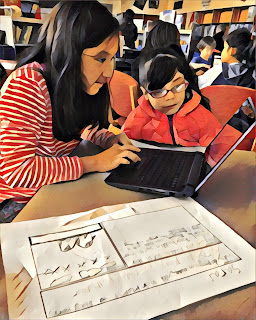School
libraries have changed a lot over the last 15 years. They are still the number
one place students have access to pleasure reading materials, but they also
hold a big opportunity to shift school culture toward student
achievement. Twenty-five
national studies have
proved that having library with an updated collection, staffed by a certified
teacher librarian who is both an educational technology evangelist and a
bibliophile can increase student achievement in a school. In 2015,
a study
was conducted in Washington State that showed a 35.6%
increase for the five-year graduation rate in high poverty schools, that
staffed a certified teacher-librarian. A study out of Colorado saw an 16%
increase in advanced reading scores for schools that kept their
teacher-librarians, then in schools that lost librarians during the recession.
South Carolina found that schools who had a full-time certified librarian and a
part-time clerical assistant, had students that scored better on their state
writing exam than schools that did not have a librarian with clerical help.
It’s
not just simply staffing a certified librarian, it’s what they are doing in
your school that will make academic impact. There are national school library
standards teacher-librarians
must teach in all grade levels. However, these
standards teach
students processes for learning, not content. Teacher-librarians teach media
literacy, inquiry process, and digital citizenship, but to truly effect student
achievement their standards must be co-taught with content teachers. The
instructional partnership of content teachers and teacher-librarians is what
leads to deeper learning of both process and content.
If
students visit the library once a week for a thirty minute “library time” and
checkout is included in that time, librarians are only able to teach each class
for 18 hours a year. These lessons are often very low level and cannot include
the level of rigor reflected in the new national library standards. Therefore,
a flexible schedule, not a coverage model is needed to increase time for
students to dig into research. Students should be able to come every day for a
week in different lengths of time with their teachers as needed to finish a
project, using the library in an authentic manner. This helps teachers too!
Research is in all our Common Core standards, but is usually taught by the
teacher, not following any inquiry process and giving students a few websites
and books to use as sources. If students don’t learn how to vet their sources,
curate the best sources, or use the information they find ethically it can have
long lasting consequences into their adult lives. In these rigorous lessons,
they also learn how to use informational text authentically and for a purpose.
The more continuous time students are using informational text the more
skillful they will become at skimming, using text features, and finding
evidence to back up their claims.
According
to OSPI, Washington State has a 16% chronic absentee rate. It is even higher
for students of color. If students need to be in school to achieve. Many
of chronic absent students don’t feel like school is a place they can be
themselves. They don’t feel successful or a sense of belonging in school. The
school library can be that third space for students. A place to create shared
experiences that merges the student’s home life and school life. The
school library creates a conduit for student’s everyday life experiences and an
echo chamber of their social, emotional, and physical needs. Students who
find a place in the library are given the opportunity to embed themselves in a
supportive community can become leaders schoolwide. Even Bill Gates attributes
some of his success to his teacher-librarian who helped him
feel a sense of belonging. Teacher-librarians ask about students’ interests and
gives students one-on-one attention they often have trouble finding in our
large public school classrooms. The library in many cases is the only
place schoolwide that is directly a student space that reflects the student
population and their interests. Libraries are a sanctuary and a life line
that can help get students to want to come to school.
The
most important way schools can help teacher-librarians make an impact on
achievement is to let them do their jobs. So often administrators don’t
understand what teacher-librarians do, so they invent jobs for them or overload
their schedules. Teacher-librarians teach, manage a space and materials,
budget, and design engaging programs for students. More and more are also
running makerspaces, coding clubs, and training students and staff on the
latest technology. Respect their role in the educational ecosystem and your
students (and their achievement scores) will thank you!
Article By: Suzanna
L. Panter
Program
Manager, School Libraries
Tacoma
Public Schools
Twitter:
@slpanter
Works
Cited
Coker,
E. Certified Teacher-Librarians, Library Quality and Student
Achievement in Washington State Public Schools. Edmonds: WA:
Washington Library Media Association, 2015.
Gates, Bill. “A Teacher Who Changed My
Life.” Gatesnotes.com, 16 Aug. 2016, www.gatesnotes.com/Education/A-Teacher-Who-Changed-My-Life.
Lance,
K., and L. Hofschire. Change in School Librarian Staffing Linked with
Change in CSAP Reading Performance, 2005 to 2011. Denver, CO: Colorado
State Library, Library Research Service, 2012.
Lance,
K., B. Schwarz, and M. J. Rodney. How Libraries Transform Schools by
Contributing to Student Success: Evidence Linking South Carolina School
Libraries and PASS & HSAP Results. Columbia: SC: South Carolina
Association of School Libraries, 2014.
“National
School Library Standards.” National School Library Standards, American Library
Association, Nov. 2017, www.standards.aasl.org.
Office
of Superintendent of Public Instruction. “Data.” Office of Superintendent of
Public Instruction, 14 July 2017, www.k12.wa.us/attendance/Data.aspx.
“School
Libraries Work! A Compendium of Research Supporting the Effectiveness of School
Libraries.” School Libraries Work!, Scholastic, www.scholastic.com/SLW2016/thanks.htm.
Sun,
Carolyn. “Washington Study Further Ties Quality Library Programs to Student
Success.” School Library Journal, Media Source, 27 May 2015, www.slj.com/2015/05/research/washington-study-further-ties-quality-library-programs-to-student-success/.


No comments:
Post a Comment